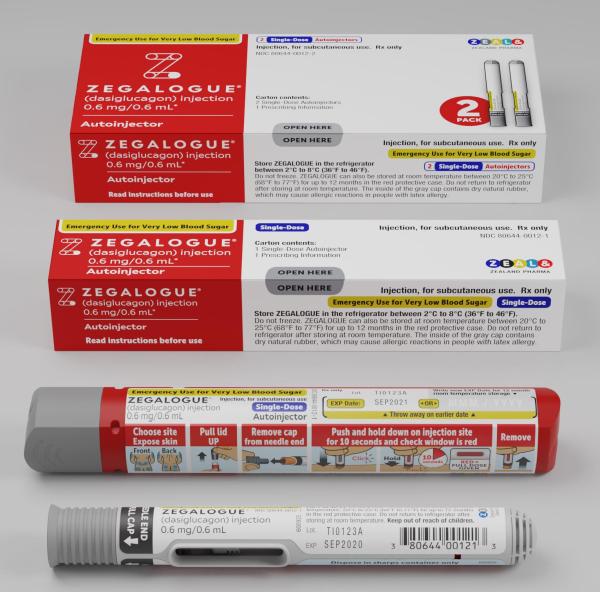Dasiglucagon Dosage
Medically reviewed by Drugs.com. Last updated on Apr 17, 2024.
Applies to the following strengths: 0.6 mg/0.6 mL
Usual Adult Dose for:
Usual Pediatric Dose for:
Additional dosage information:
Usual Adult Dose for Hypoglycemia
0.6 mg subcutaneously once into lower abdomen, buttocks, thigh, or outer upper arm
If there has been no response after 15 minutes, a second 0.6 mg dose may be administered
Comments:
- Patients/caregivers should be familiar with instructions for use; this drug should be administered as soon as possible when severe hypoglycemia is recognized.
- Call for emergency assistance immediately after administering dose.
- Once patient has responded to treatment, oral carbohydrates should be given to restore liver glycogen stores.
Use: For the treatment of severe hypoglycemia in patients with diabetes.
Usual Pediatric Dose for Hypoglycemia
6 years or older: 0.6 mg subcutaneously once into lower abdomen, buttocks, thigh, or outer upper arm
If there has been no response after 15 minutes, a second 0.6 mg dose may be administered
Comments:
- Patients/caregivers should be familiar with instructions for use; this drug should be administered as soon as possible when severe hypoglycemia is recognized.
- Call for emergency assistance immediately after administering dose.
- Once patient has responded to treatment, oral carbohydrates should be given to restore liver glycogen stores.
Use: For the treatment of severe hypoglycemia in pediatric patients 6 years or older with diabetes.
Renal Dose Adjustments
No adjustment recommended
Liver Dose Adjustments
No adjustment recommended
Precautions
CONTRAINDICATIONS:
- Pheochromocytoma
- Insulinoma
Safety and efficacy have not been established in patients younger than 6 years.
Consult WARNINGS section for additional precautions.
Dialysis
Data not available
Other Comments
Administration advice:
- For subcutaneous administration only
- Inject into outer upper arms, lower abdomen, front or back of thighs, or buttocks; roll back clothing to expose bare skin; do not inject through clothes
- The autoinjector and prefilled syringe each contain a single dose; do not reuse
- Review instructions for use with patient/caregivers prior to, and each time medicine is dispensed
Storage requirements:
- Store in refrigerator 36F to 46F (2C to 8C) in red protective case; do not freeze
- May store at room temperature (68F to 77F [20C to 25C]) for up to 12 months; do not return to refrigerator after storing at room temperature
- Upon removal from refrigerator, date label with new expiration date
Reconstitution/preparation techniques:
- Consult instructions for use included in packaging; be familiar with use before an emergency occurs
- AUTOINJECTOR: Pull gray cap off, push and hold straight down on skin until the yellow needle guard is fully pressed down (you may hear a click); keep holding down for 10 seconds and/or until the medicine window turns red (you may hear a second click); remove by lifting straight up; dispose of in a sharps container
- PREFILLED SYRINGE: Remove gray needle cover, pinch skin, and insert entire needle into skin at a 45-degree angle, release skin, and slowly press plunger until plunger rod stops; remove needle carefully; dispose of in a sharps container
General:
- The inside of the gray cap on the prefilled syringe and autoinjector contains a dry natural rubber (a derivative of latex).
- Patients/caregivers should be familiar with administration and management of severe hypoglycemia prior to an emergency; emergency help should be sought after administration as hypoglycemia may occur after treatment.
- This product has a shelf-life of 36 months at refrigerated temperatures and is stable for up to 12 months at room temperature.
Monitoring:
- Blood glucose should be monitored to ensure efficacy; frequent monitoring of blood glucose should occur after a severe hypoglycemic episode.
Patient advice:
- Patients/caregivers should be instructed to read the US FDA-approved patient labeling (Patient Information and Instructions for Use).
- Patients/caregivers should be able to recognize the signs and symptoms of severe hypoglycemia and know the risks of prolonged hypoglycemia.
- Patients/caregivers should understand the risk of allergic reactions and seek immediate medical attention if symptoms of a serious hypersensitivity reaction develop.
More about dasiglucagon
- Check interactions
- Compare alternatives
- Side effects
- During pregnancy
- Drug class: glucose elevating agents
- Breastfeeding
- En español
Patient resources
Other brands
Professional resources
Other brands
Related treatment guides
Further information
Always consult your healthcare provider to ensure the information displayed on this page applies to your personal circumstances.


